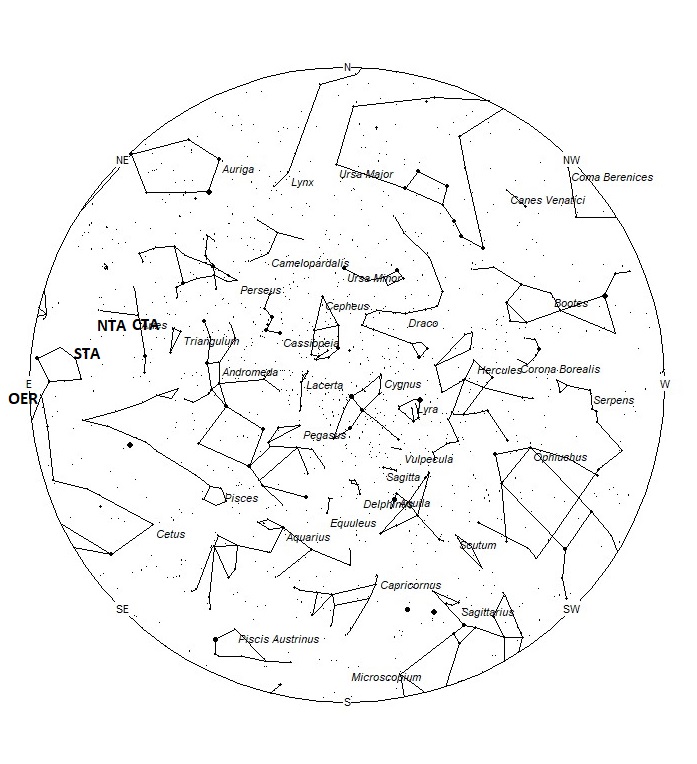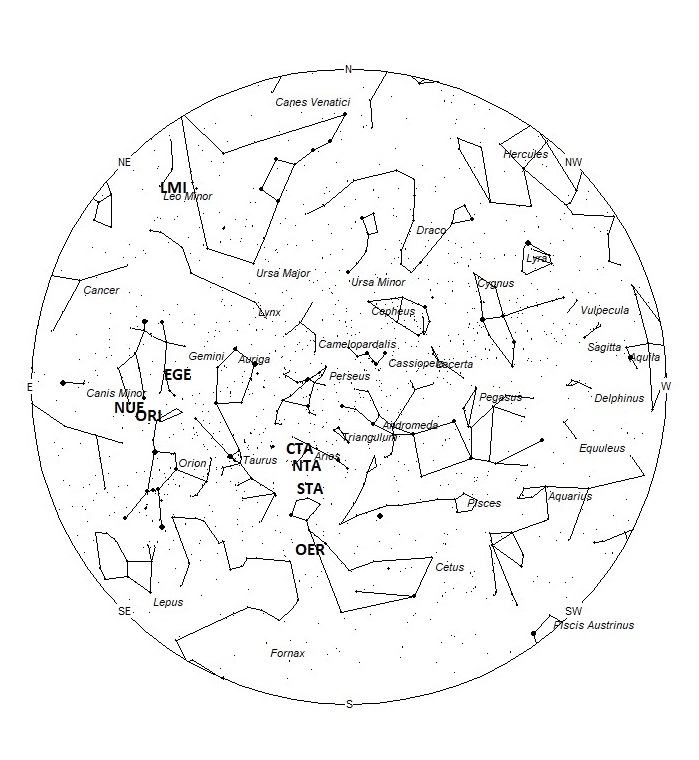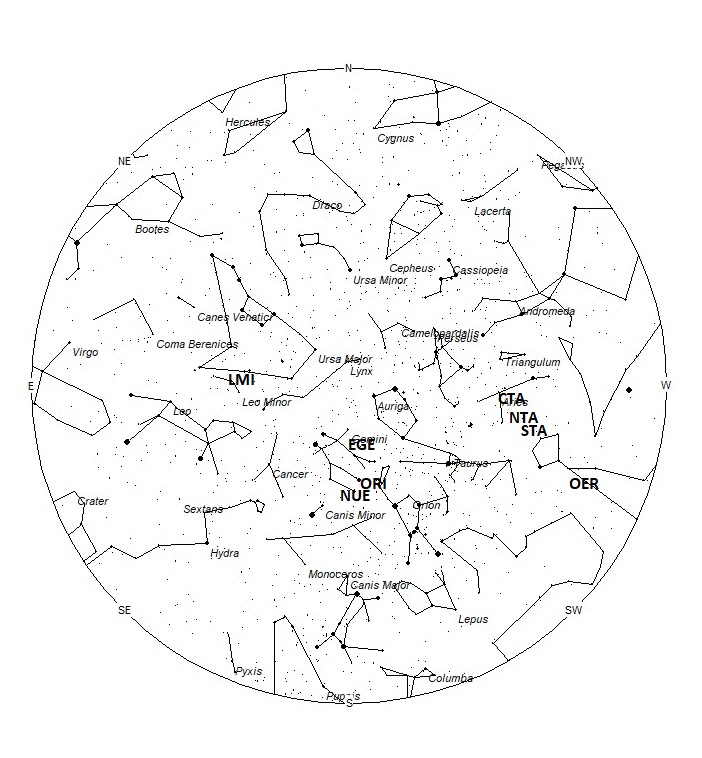During this period, the moon reaches its first quarter phase on Thursday October 22nd. At that time, the moon is located 90 degrees east of the sun and sets near 23:00 local summer time (LST) as seen from most mid-northern latitude locations. This weekend the waxing crescent moon will set during the early evening hours and will not interfere with meteor observing. The estimated total hourly meteor rates for evening observers this week is near 4 as seen from mid-northern latitudes and 3 as seen from tropical southern locations (25S). For morning observers, the estimated total hourly rates should be near 25 as seen from mid-northern latitudes (45N) and 20 as seen from tropical southern locations (25S). The actual rates will also depend on factors such as personal light and motion perception, local weather conditions, alertness, and experience in watching meteor activity. Note that the hourly rates listed below are estimates as viewed from dark sky sites away from urban light sources. Observers viewing from urban areas will see less activity as only the brighter meteors will be visible from such locations.
The radiant (the area of the sky where meteors appear to shoot from) positions and rates listed below are exact for Saturday night/Sunday morning October 17/18. These positions do not change greatly day to day so the listed coordinates may be used during this entire period. Most star atlases (available at science stores and planetariums) will provide maps with grid lines of the celestial coordinates so that you may find out exactly where these positions are located in the sky. A planisphere or computer planetarium program is also useful in showing the sky at any time of night on any date of the year. Activity from each radiant is best seen when it is positioned highest in the sky, either due north or south along the meridian, depending on your latitude. It must be remembered that meteor activity is rarely seen at the radiant position. Rather they shoot outwards from the radiant, so it is best to center your field of view so that the radiant lies at the edge and not the center. Viewing there will allow you to easily trace the path of each meteor back to the radiant (if it is a shower member) or in another direction if it is a sporadic. Meteor activity is not seen from radiants that are located far below the horizon. The positions below are listed in a west to east manner in order of right ascension (celestial longitude). The positions listed first are located further west therefore are accessible earlier in the night while those listed further down the list rise later in the night.
These sources of meteoric activity are expected to be active this week.
.
The Southern Taurids (STA) are active from a large radiant centered at 02:34 (038) +11. This area of the sky is located in southern Aries, 3 degrees northwest of the 4th magnitude star known as mu Ceti. This source is best placed near 0100 LST when it is located highest in the sky. Current hourly rates would be near 3 no matter your location. With an entry velocity of 27 km/sec., most activity from this source would possess medium-slow velocities.
The omicron Eridanids (OER) were discovered by Japanese observers using video data from SonotoCo in 2007-2008. The activity period ranges from October 16 – November 24 with maximum activity occurring on November 5th. This is a weak shower that usually produces rates less than 1 per hour, even at maximum activity. The radiant is currently located at 02:34 (038) -05, which places it in eastern Cetus, 4 degrees southeast of the currently 4th magnitude variable star known as Mira (omicron Ceti). This location is close to the source of the Southern Taurids so care must be taken to separate these meteors. Like the STA’s these meteors may be seen all night long but the radiant is best placed near 0100 LST when it lies on the meridian and is located highest in the sky. With an entry velocity of 29 km/sec., the average omicron Eridanid meteor would be of medimu-slow velocity.
The Northern Taurids (NTA) are now active from a large radiant centered at 02:50 (043) +20. This area of the sky is located in central Aries, 4 degrees west of the 4th magnitude star known as Botein (delta Arietis). This source is best placed near 0100 LST when it is located highest in the sky. Current hourly rates would be near 1 as seen from the northern hemisphere and less than 1 as seen from south of the equator. With an entry velocity of 27 km/sec., most activity from this source would possess medium-slow velocities.
The chi Taurids (CTA) were discovered by Dr. Peter Brown during his 7 year survey using the Canadian Meteor Orbit Radar (CMOR). This source is active from October 20 through November 17 with a maximum occurring near November 4th. Current rates would be less than 1 per hour no matter your location. The radiant is currently located at 03:02 (046) +23, which places it in eastern Aries , 3 degrees northwest of the 4th magnitude star known as Botein (delta Arietis). This location is close to the source of the Northern Taurids so care must be taken to separate these meteors. These meteors may be seen all night long but the radiant is best placed near 0200 LST when it lies on the meridian and is located highest in the sky. With an entry velocity of 41 km/sec., the average chi Taurid meteor would be of medium velocity.
The Orionids (ORI) are active from a radiant located at 06:17 (094) +16. This area of the sky lies in northeastern Orion, 4 degrees southwest of the 2nd magnitude star known as Alhena (gamma Geminorum). The radiant is best placed near 0500 LST, when it lies highest above the horizon. Hourly rates would be near 5 per as seen from the northern hemisphere and 4 as seen from south of the equator. With an entry velocity of 66 km/sec., most activity from this radiant would be of swift velocities.
The nu Eridanids (NUE) were co-discovered by Japanese observers using SonotoCo and Juergen Rendtel and Sirko Molau of the IMO. Activity from this long-period stream stretches from August 24 all the way to November 16. Maximum activity occurred on September 24th. The radiant currently lies at 06:40 (100) +11, which places it in northern Monoceros, 2 degrees southwest of the 3rd magnitude star known as Alzirr (xi Geminorum). This is close to the Orionid radiant and care must be taken to separate the two when observing. This area of the sky is best seen during the last dark hour before dawn when the radiant lies highest in a dark sky. Current rates are expected to be near 1 per hour during this period no matter your location. With an entry velocity of 67 km/sec., the average meteor from this source would be of swift velocity.
The epsilon Geminids (EGE) are active from September 30 through October 25 with maximum activity occurring on October 11. The radiant is currently located at 06:47 (102) +28, which places it in northern Gemini, directly between the two 3rd magnitude star known as theta and epsilon Geminorum. This area of the sky is best placed in the sky during the last hour before dawn, when it lies highest above the horizon in a dark sky. Current rates would be near 2 per hour as seen from the northern hemisphere and near 1 as seen from southern of the equator. With an entry velocity of 70 km/sec., most activity from this radiant would be of swift velocities.
The Leonis Minorids (LMI) are active from October 12-Nov 5 with maximum activity occurring on October 23rd. This radiant is currently located at 10:22 (156) +38, which places it in northern Leo Minor, 3 degrees south of the 3rd magnitude star known as mu Ursae Majoris. The radiant is best placed just before dawn when it lies highest in a dark sky. This shower is better situated for observers situated in the northern hemisphere where the radiant rises far higher into the sky before the start of morning twilight. Current rates would be near 1 per hour as seen from the northern hemisphere and less than 1 as seen from south of the equator. At 62km/sec., the average Leonis Minorid is swift. From my personal experience this minor shower produces a high proportion of bright meteors.
As seen from mid-northern hemisphere (45N), sporadic morning rates would be near 10 per hour as seen from rural observing sites and 3 per hour during the evening hours. As seen from the tropical southern latitudes (25S), one would expect to see approximately 7 sporadic meteors per hour during the last hour before dawn as seen from rural observing sites. Evening rates would be near 2 per hour. Locations between these two extremes would see activity between the listed figures.
The list below offers the information from above in tabular form. Rates and positions are exact for Saturday night/Sunday morning except where noted in the shower descriptions.
| SHOWER | DATE OF MAXIMUM ACTIVITY | CELESTIAL POSITION | ENTRY VELOCITY | CULMINATION | HOURLY RATE | CLASS |
| RA (RA in Deg.) DEC | Km/Sec | Local Summer Time | North-South | |||
| Southern Taurids (STA) | Nov 03 | 02:34 (038) +11 | 27 | 01:00 | 3 – 3 | II |
| omicron Eridanids (OER) | Nov 05 | 02:34 (038) -05 | 29 | 01:00 | <1 – <1 | IV |
| Northern Taurids (NTA) | Nov 12 | 02:50 (043) +20 | 27 | 01:00 | 1- <1 | II |
| chi Taurids (CTA) | Nov 04 | 03:02 (046) +23 | 27 | 02:00 | 2 – 2 | II |
| Orionids (ORI) | Oct 21 | 06:17 (094) +16 | 66 | 05:00 | 5 – 4 | I |
| nu Eridanids (NUE) | Sep 24 | 06:40 (100) +11 | 67 | 06:00 | 1 – 1 | IV |
| epsilon Geminids (EGE) | Oct 11 | 06:47 (102) +28 | 70 | 06:00 | 2 – 1 | II |
| Leonis Minorids (LMI) | Oct 23 | 10:22 (156) +38 | 62 | 10:00 | 1 – <1 | II |









